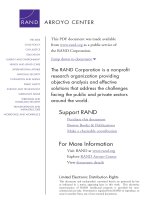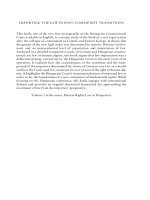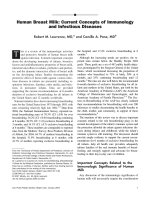human genetics
Bạn đang xem bản rút gọn của tài liệu. Xem và tải ngay bản đầy đủ của tài liệu tại đây (1.25 MB, 28 trang )
Human Genetics
•
Phenotype: observed physical and
functional traits
•
Genotype: complete set of genes and alleles
•
Alleles: Different versions of homologous
genes ex. B and b
Human genetics
•
How are gametes made?
•
How does chromosome behavior affect
inheritance of traits?
•
Somatic cells are diploid.
•
Gametes are haploid, with only one set of
chromosomes
egg
polar
body
spermatogonium
primary
spermatocyte
secondary
spermatocyte
oogonium
primary
oocyte
secondary
oocyte
polar bodies
(will be degraded)
spermatids
meiosis ll
meiosis l
SPERMATOGENESIS OOGENESIS
a
b
1st law - segregation of alleles
•
Cells contain 2 copies (alleles) of each gene
•
Alleles separate during gamete formation
(meiosis)
•
gametes carry only one copy of each gene
Figure 19.2
Possible genotypes
and
their probabilities
Punnett squares
show parental
gametes
and the genotypes
of next generation
•
Homozygous: BB and bb
•
Heterozygous: Bb
Law of Independent Assortment
•
During gamete formation, genes for
different traits separate
independently into gametes
•
Why? random alignment of homologues at
Meiosis I
Copyright © 2003 Pearson Education, Inc. publishing as Benjamin Cummings
Figure 9.17
Chromosome behavior accounts for Mendel’s
principles
Copyright © 2003 Pearson Education, Inc. publishing as Benjamin Cummings
A B
a
b
Tetrad
Crossing over
A B
a
ba
B
A b
Gametes
•
Genes on the same chromosome tend to be
inherited together = linked genes
• Crossing over produces gametes with
recombinant chromosomes
Copyright © 2003 Pearson Education, Inc. publishing as Benjamin Cummings
•
an offspring’s
phenotype is
intermediate
between the
phenotypes of its
parents
Incomplete dominance
P GENERATION
F
1
GENERATION
F
2
GENERATION
Red
RR
Gametes R r
White
rr
Pink
Rr
R r
R R
r r
1
/
2
1
/
2
1
/
2
1
/
2
1
/
2
1
/
2
SpermEggs
Pink
Rr
Pink
rR
White
rr
Red
RR
Figure 9.12A
VARIATIONS ON MENDEL’S PRINCIPLES
Copyright © 2003 Pearson Education, Inc. publishing as Benjamin Cummings
•
Incomplete dominance in human
hypercholesterolemia
Figure 9.12B
GENOTYPES:
HH
Homozygous
for ability to make
LDL receptors
Hh
Heterozygous
hh
Homozygous
for inability to make
LDL receptors
PHENOTYPES:
LDL
LDL
receptor
Cell
Normal Mild disease Severe disease
Copyright © 2003 Pearson Education, Inc. publishing as Benjamin Cummings
Ex. three alleles for ABO blood type in humans
I
A
, I
B
, i
Many genes have more than two alleles
in the population
Copyright © 2003 Pearson Education, Inc. publishing as Benjamin Cummings
•
Quantitative traits
skin color, height, eye color
Polygenic traits - A single trait may be influenced
by many genes
Fraction of population
Skin pigmentation
Copyright © 2003 Pearson Education, Inc. publishing as Benjamin Cummings
•
The inheritance of many
human traits follows
Mendel’s principles and
the rules of probability
Genetic traits in humans can be tracked
through family pedigrees
Figure 9.8A
Copyright © 2003 Pearson Education, Inc. publishing as Benjamin Cummings
•
Family pedigrees are used to determine
patterns of inheritance and individual
genotypes
Figure 9.8B
Dd
Joshua
Lambert
Dd
Abigail
Linnell
D_
Abigail
Lambert
Female
Dd
Elizabeth
Eddy
D_
John
Eddy
? D_
Hepzibah
Daggett
?
?
ddDdDdDdddDdDd
Male
Deaf
Hearing
dd
Jonathan
Lambert
Copyright © 2003 Pearson Education, Inc. publishing as Benjamin Cummings
Inherited Genetic Disorders
•
Most mutations
usually involve
recessive alleles
•
Phenylketonuria,
PKU
•
Tay-Sachs disease
•
Cystic fibrosis
Figure 9.9A
D D
d d
Normal
Dd
Normal
Dd
DD
Normal
Dd
Normal
(carrier)
Dd
Normal
(carrier)
dd
Deaf
Eggs Sperm
PARENTS
OFFSPRING
Copyright © 2003 Pearson Education, Inc. publishing as Benjamin Cummings
•
A few are caused by dominant alleles
Figure 9.9B
–
Examples: achondroplasia, Huntington’s disease
Copyright © 2003 Pearson Education, Inc. publishing as Benjamin Cummings
•
Most sex-linked human
disorders are due to
recessive alleles
–
Ex: hemophilia,
red-green color blindness
These traits appear mostly in males. Why?
–
If a male receives a single X-linked recessive
allele from his mother, he will have the disorder;
while a female has to receive the allele from both
parents to be affected
Sex-linked disorders affect mostly males
Figure 9.23A
Copyright © 2003 Pearson Education, Inc. publishing as Benjamin Cummings
Pedigree Chart: Inheritance Pattern for an X-linked
Recessive Disease
Figure 19.12
Copyright © 2003 Pearson Education, Inc. publishing as Benjamin Cummings
•
A high incidence of hemophilia has plagued the
royal families of Europe
Figure 9.23B
Queen
Victoria
Albert
Alice Louis
Alexandra Czar
Nicholas II
of Russia
Alexis
Copyright © 2003 Pearson Education, Inc. publishing as Benjamin Cummings
Variations on Mendel’s Principles
•
Codominance, multiple alleles
•
Pleiotropy
•
Polygenic traits
•
Sex-linked genes
•
Environmental effects
Copyright © 2003 Pearson Education, Inc. publishing as Benjamin Cummings
•
Abnormal
chromosome count
is a result of
nondisjunction
–
homologous
pairs fail to
separate
during
meiosis I
Accidents during meiosis can alter
chromosome number
Figure 8.21A
Nondisjunction
in meiosis I
Normal
meiosis II
Gametes
n + 1 n + 1 n – 1 n – 1
Number of chromosomes
Copyright © 2003 Pearson Education, Inc. publishing as Benjamin Cummings
–
Or sister chromatids fail to separate during
meiosis II
Figure 8.21B
Normal
meiosis I
Nondisjunction
in meiosis II
Gametes
n + 1 n – 1 n n
Number of chromosomes
Copyright © 2003 Pearson Education, Inc. publishing as Benjamin Cummings
•
An extra chromosome 21 causes Down syndrome
•
The chance of having a Down syndrome child goes up
with maternal age
Figure 8.20C
Copyright © 2003 Pearson Education, Inc. publishing as Benjamin Cummings
•
Karyotyping and biochemical tests of fetal cells
can help people make reproductive decisions
–
Fetal cells can be obtained through
amniocentesis
Fetal testing can spot many inherited disorders
early in pregnancy
Figure 9.10A
Amniotic
fluid
Fetus
(14-20
weeks)
Placenta
Amniotic
fluid
withdrawn
Centrifugation
Fetal
cells
Fluid
Uterus Cervix
Cell culture
Several
weeks later
Karyotyping
Biochemical
tests









